Are you thinking about visiting Channel Islands National Park but aren’t sure what to expect when you want to go? Then this guide is for you.
I’m James and I’m a national park expert. In this guide, I’ll go into detail for each month about exactly what to expect, so you can plan a trip that suits your needs. I share all you need to know about the weather in the Channel Islands National Park, as well as when the ferries operate, what activities are available, what wildlife to see, etc. so you can make an informed choice about when to go.
‼️ If you just want a quick snapshot about my thoughts on the best time to visit Channel Islands National Park, check out my Best Time to Go to Channel Islands National Park guide. ‼️
No time right now to discover the best time to visit Channel Islands National Park. Pin It and save it for later:
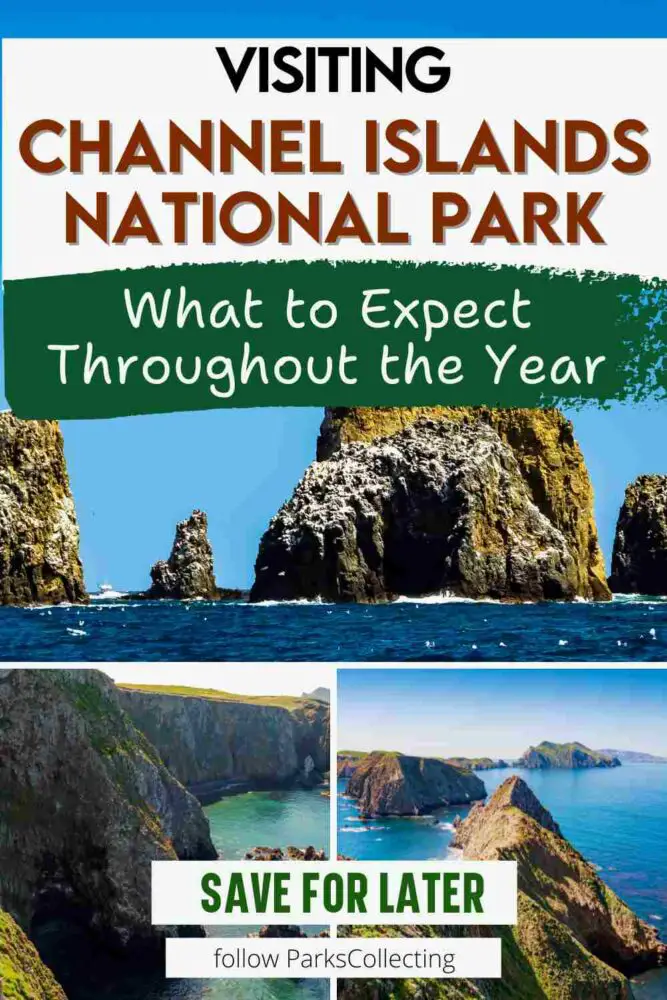
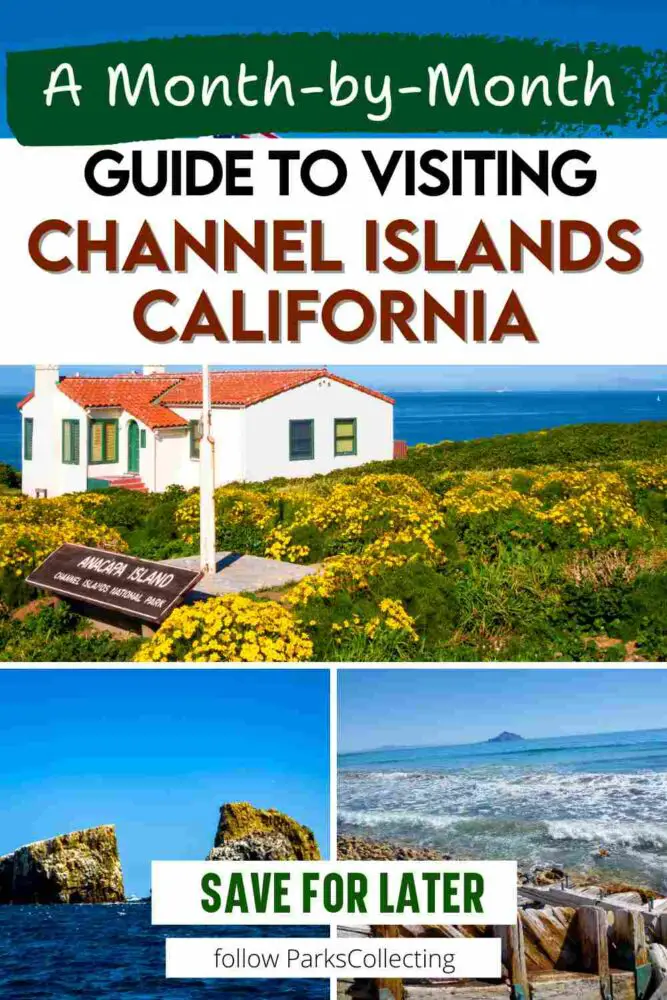
🛏️TOP HOTEL PICK: Check availability now
🚘FIND THE CHEAPEST CAR RENTAL: Search Discover Cars for the best deals
✈️FIND THE CHEAPEST FLIGHTS: Search Skyscanner for the best deals<
🧳GET TRAVEL INSURANCE: Get insured with Travelex before you go
Subscribe to daily national parks planning tips, travel inspiration and trip ideas and get instant access to the free PDF of this guide to
“Visiting Channel Islands National Park: What To Expect Throughout the Year”
Table of Contents
Channel Islands National Park in Spring (March – May)
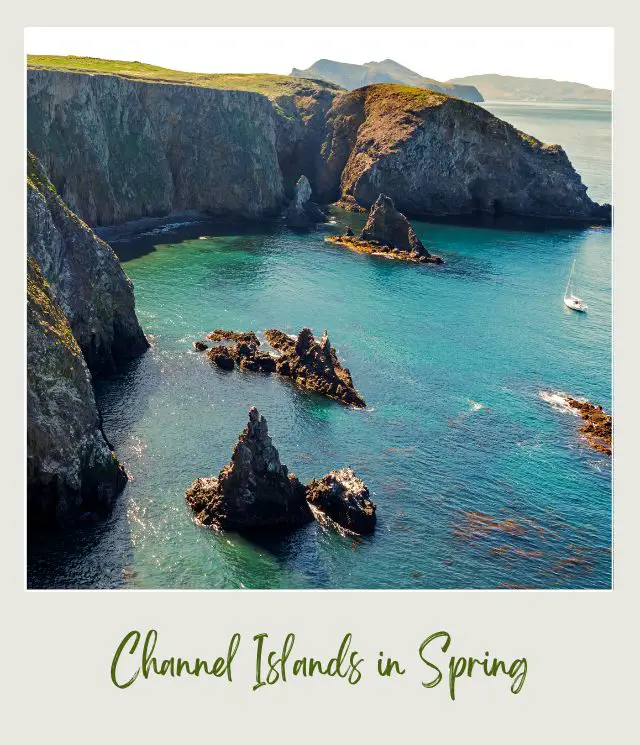
While you can visit two of the Channel Islands in early spring, you’ll have to wait until April to head to the other three. Spring in this part of California runs between March and May. Here’s what to expect at Channel Islands National Park during each month of spring.
Visiting Channel Islands National Park in March
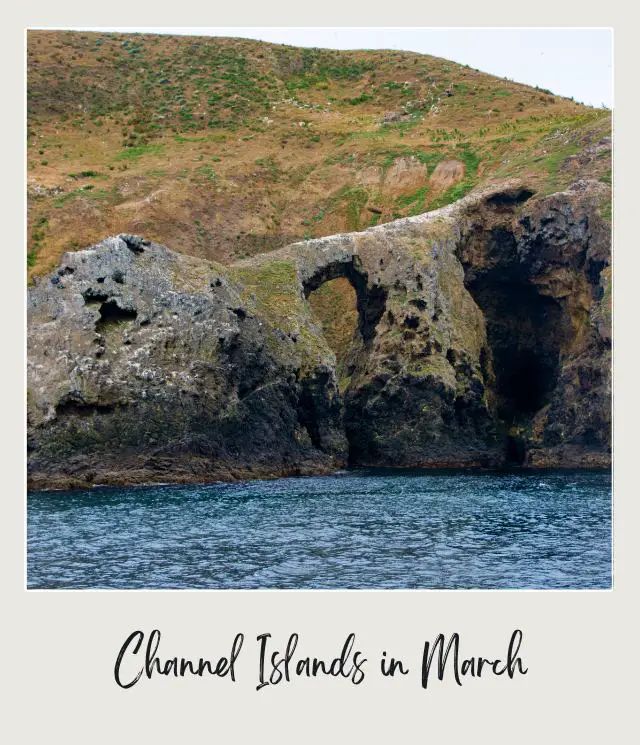
Though it’s considered spring at Channel Islands National Park in March, in reality this is the fourth-coldest month of the year. Therefore, you can expect temperatures, day and night, to range between 39°F (4°C) and 63°F (17°C). This means the weather is still mild, without any hot or freezing extremes.
Most of the rain on the islands tends to fall between November and April. Precipitation tends to present as storms that last for a few days, rather than showers. While March is one of the wetter months, it’s not as wet as January or February. The pattern of rainfall here is very variable, so what the Channel Islands weather is really can depend on whether a storm occurs during your visit.
Note that you cannot reach Santa Barbara, San Miguel or Santa Rosa islands during March as the boats don’t operate then. So, if you do want to head here in early spring, you’ll need to go to Anacapa (limited service) or Santa Cruz.
You might see some wildflowers blooming on the islands by late March. If you get lucky, you could also spot gray whales migrating off the coast during March.
Pros
- Not as cold or wet as winter
- Wildflowers may bloom by late March
- You might spot migrating gray whales
Cons
- No ferries to Santa Barbara, San Miguel or Santa Rosa. Few to Anacapa.
- The fourth-coldest month of the year
- Rainstorms can occur in March
Visiting Channel Islands National Park in April
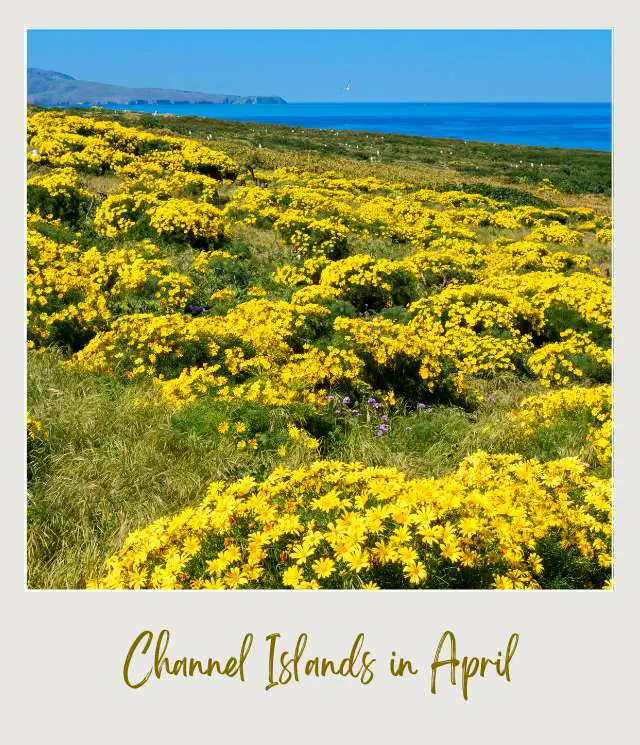
By April, the weather on the Channel Islands in California is starting to warm up a little. Temperatures are similar to those of November, with daily highs of about 66°F (19°C) and lows of around 41°F (5°C).
You can still expect April showers in mid-spring. It’s not the dry season here until May, so you might encounter storms lasting for several days. While April tends to see less rain than the preceding months, it’s not as dry as late spring. Fog is also more likely during spring and summer.
Boat services to Santa Barbara, San Miguel and Santa Rosa commence in April, so you can begin to access these three islands then, in addition to Anacapa and Santa Cruz. Note, though, that these services only operate to Santa Barbara and San Miguel a few times per month. Santa Rosa services, however, run several times per week, as do ferries to Anacapa and Santa Cruz.
You should also see wildflowers in April, though the season for gray whale migration will have passed by now. Seabirds do begin to nest at this time of year, though.
As the season is just starting, April is a quiet time to head to the islands, so may be a good choice if you want to avoid the crowds.
Pros
- Ferry services to all five islands commence in April
- You can see spring wildflowers and nesting birds
- It’s a peaceful time of year at the park
- Whale watching available until mid-April
Cons
- It’s still wet season in April
- Storms may bring several days of rain
- Boat services only begin operating this month
- There are often plankton blooms and green water; not great for diving
- Birds nest on Anacapa April – mid-August. You may encounter guano, strong odor, constant noise, bird carcasses, and birds protecting their territory.
Visiting Channel Islands National Park in May

By May, you can start to expect less chance of rainstorms at Channel Islands National Park. This part of California is entering the dry season, and only 5% of the rain annually falls between May and October.
In May, temperatures range from about 45°F (7°C) to around 68°F (20°C). So by day it’s mild or even warm, but not hot. It can still be quite chilly at night. Fog is fairly likely in May, which can affect visibility.
By May, it’s easy to reach all five islands by ferry, though do check in advance as days and dates of operation do vary. Depending on the island, boats operate several times per week or month.
May is prior to peak tourist season, so the islands can be relatively peaceful during this month. Though it’s still really warm enough for swimming and snorkeling.
Pros
- The dry season commences in May
- Mild to warm daytime temperatures
- Ferries are now fully operational
Cons
- It’s a little cold for swimming and snorkeling
- Camping season isn’t yet underway
- Overnight chills are still possible
- There are often plankton blooms and green water; not great for diving
- Birds nest on Anacapa April – mid-August. You may encounter guano, strong odor, constant noise, bird carcasses, and birds protecting their territory.
Channel Islands National Park in Summer (June – August)
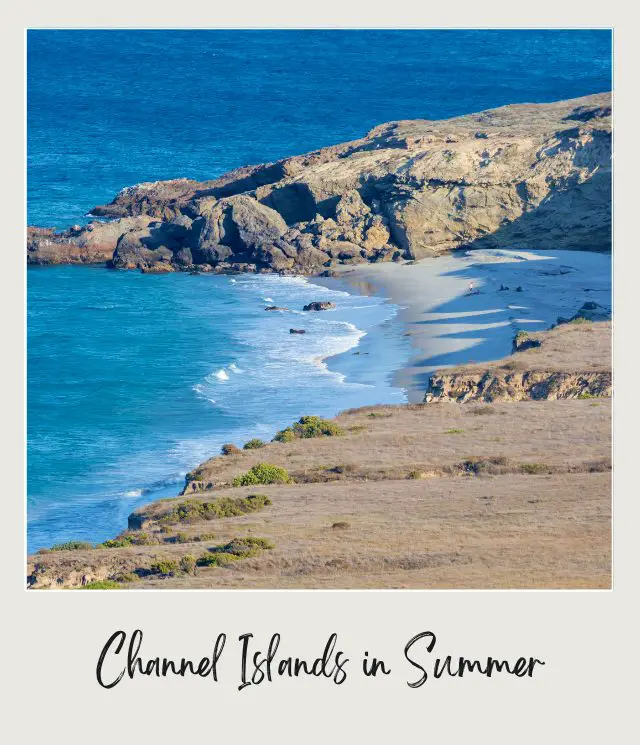
As with many other US National Parks, summer is peak season in the California Channel Islands. More tourists head here in June, July and August than at any other time of year. It’s a popular time to visit, especially for those who want to camp out, swim or snorkel.
Visiting Channel Islands National Park in June
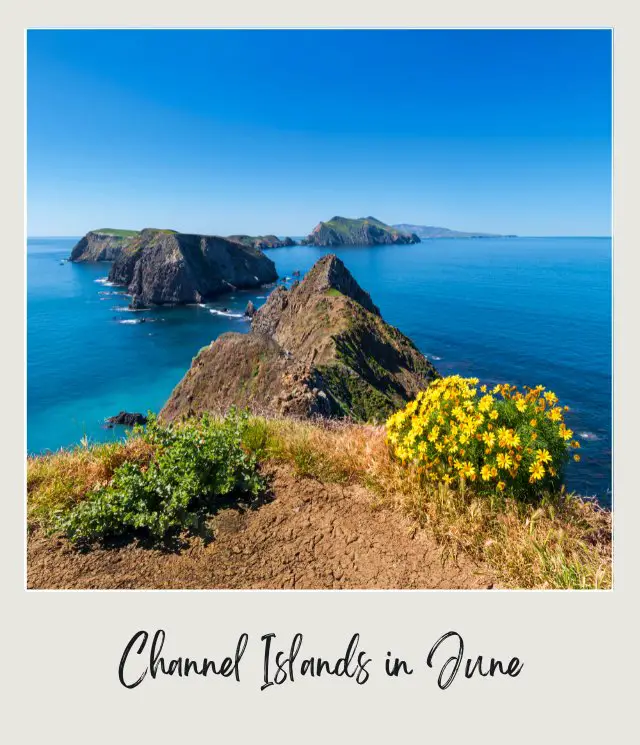
Head to Channel Islands National Park during June and you can experience early summer. The weather is a little cooler than in July, August and even September. In fact temperatures are comparable to those of October.
Daily minimums can be around 46°F (8°C), with maximums of about 72°F (22°C). The dry season is well underway by now, so you can expect little to no rainfall throughout the first month of summer.
By June, swimming, snorkeling and camping season may be starting – if it’s warm enough. Plus ferry services to all five islands are operating. You might also spot humpback or blue whales offshore from now until October.
Pros
- It’s the dry season
- Humpback or blue whales may be seen offshore
- It may be warm enough to camp, swim or snorkel
Cons
- Not as warm as July, August and September
- The tourist crowds are starting to descend
- There are often plankton blooms and green water; not great for diving
- Birds nest on Anacapa April – mid-August. You may encounter guano, strong odor, constant noise, bird carcasses, and birds protecting their territory.
Visiting Channel Islands National Park in July
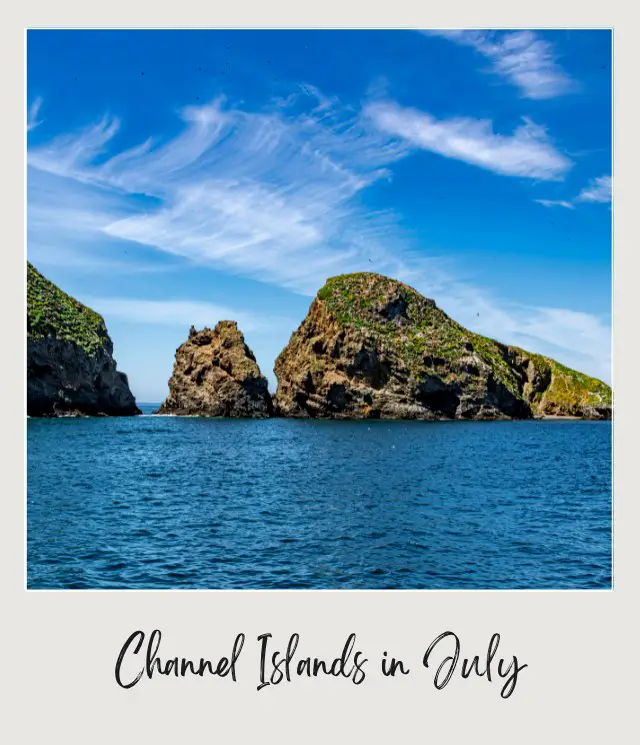
July and September are two of the finest months, weather wise, at Channel Islands National Park. Only August is hotter. This is a very popular time to visit, so you can expect crowds during the peak summer season.
Low temperatures for July start at around 50°F (10°C), while highs can reach about 75°F (24°C). The coastal breezes here do help to temper the heat, and you can expect very little rain in July.
Swimming and snorkeling are popular during July, and ferry services to all of the islands operate throughout the week or month. The tourist infrastructure is well set up during summer, but of course on the downside this means you’ll be sharing the islands with a higher number of other visitors.
Look out for blue or humpback whales offshore during July. While you might see fog in July, this is less likely than during the preceding spring and early summer months.
Pros
- Fine summer weather
- Swimming, snorkeling and camping season. Water temperature is pleasant from about mid-July.
- You may spot blue or humpback whales offshore
Cons
- One of the busiest months
- Ferry services may be fully booked way ahead of time
- Birds nest on Anacapa April – mid-August. You may encounter guano, strong odor, constant noise, bird carcasses, and birds protecting their territory.
Visiting Channel Islands National Park in August
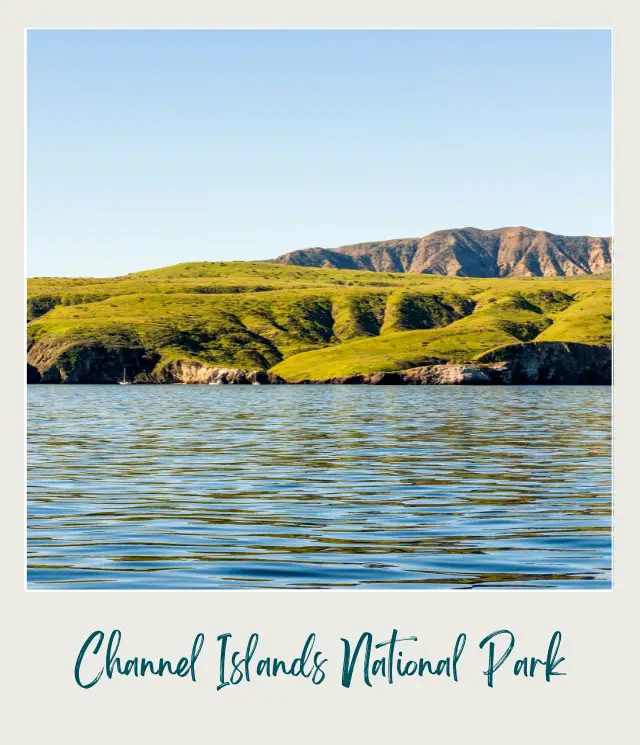
August is the hottest month at Channel Islands National Park. This is also the middle of the dry season, so you can expect warm weather with virtually no rain. Averages during August are in the range of about 50°F (10°C) to around 77°F (25°C).
Like July, and to a lesser extent June, this is peak tourist season. So you can expect higher visitor numbers and crowded ferries. As with July, book well in advance if you want to secure a place on the boat and decent accommodation during summer.
August has ideal weather for snorkeling and swimming in the ocean. Camping is also very popular at this time of the year. You can still look out for blue and humpback whales offshore too. In summer, you can also see seals being born or seabirds leaving their nests.
Pros
- The warmest month of the year
- Good swimming and snorkeling conditions. Water temperature is pleasant.
- Blue or humpback whales can still be seen offshore
Cons
- It can get very crowded
- You’ll need to book way ahead of time
- Birds nest on Anacapa April – mid-August. You may encounter guano, strong odor, constant noise, bird carcasses, and birds protecting their territory.
Channel Islands National Park in Fall (September – November)
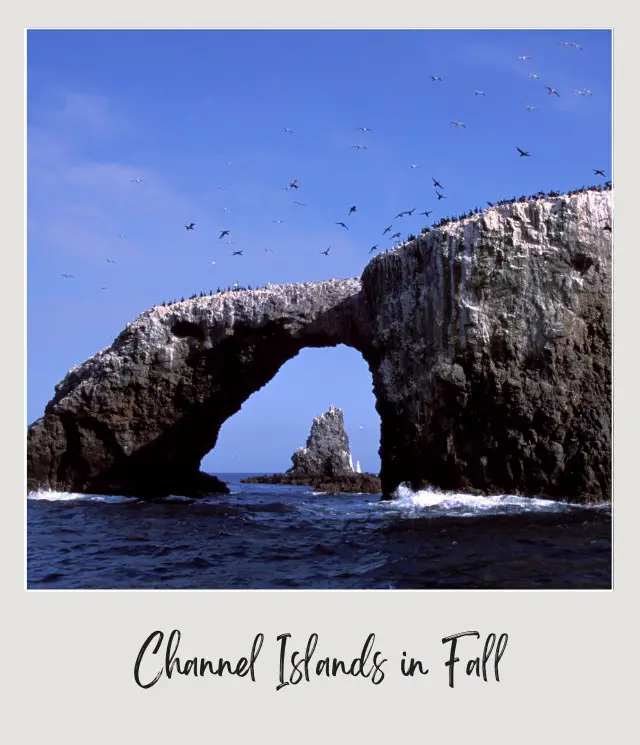
Head to the Channel Islands National Park in early fall and you could still experience summery weather. Even later in fall, it’s more-or-less as warm as in late spring. From September onwards, there’s also fewer tourists at the park.
Visiting Channel Islands National Park in September
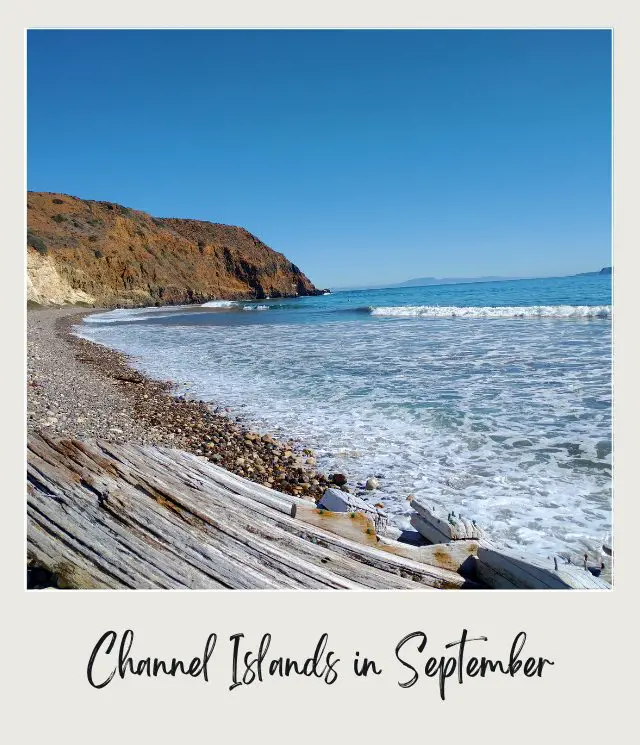
In terms of temperatures, September is just as warm as June and July on the Channel Islands. As the ocean has had some time to heat up over summer, this is also a good time of year for snorkeling and swimming. Visibility is also generally good, and it’s still the dry season, too.
Average September temperatures can reach as high as around 77°F (25°C), with lows of about 48°F (9°C). So it’s still warm during the day, and tolerable at night.
A key advantage of leaving your visit until early fall is that the tourist crowds will have started to thin out by now. There’s not quite so much pressure on boat services and accommodations, though it’s still wise to book in advance if you can.
September is a little early for fall bird migration, but you can still see blue and humpback whales until next month.
Pros
- Warm, dry weather
- Ocean temperatures are comfortable
- Blue and humpback whales might still be seen
- Diving visibility is good
Cons
- Less hours of daylight than during summer
- Too early for fall bird migration
Visiting Channel Islands National Park in October
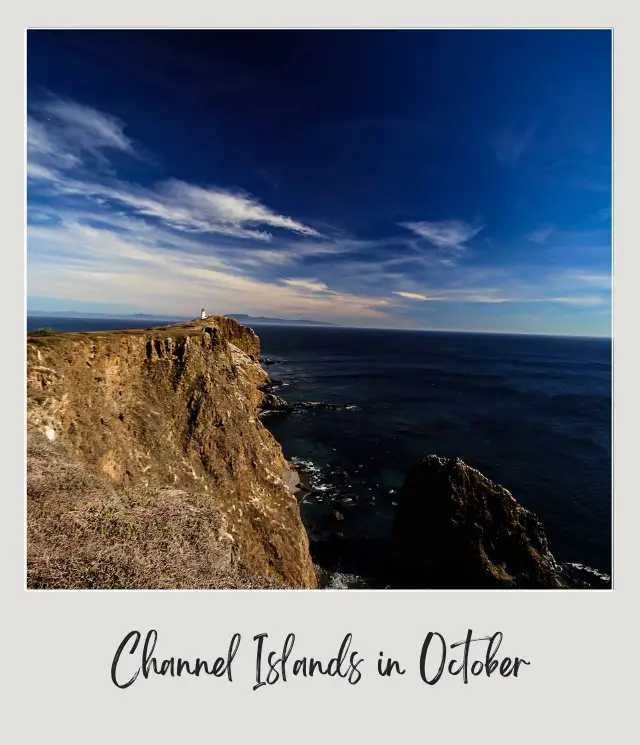
In October on the Channel Islands, you can expect similar weather to June, although there are fewer hours of daylight. This is the last month of the dry season, so you can also expect there to be little or no rain.
As in June, then, be prepared for daily minimums of about 46°F (8°C), with highs of around 72°F (22°C). Ferries still operate several times per week, or month, in October, depending on the island you want to visit.
Though the islands are starting to cool down a little, this means thinner crowds. If you don’t mind shorter days, it’s just as warm and dry as early summer.
October also brings the last chance of the year to spot blue or humpback whales. You may also find it’s still warm enough for snorkeling and swimming, especially early in the month. Bird migration may begin in October too.
Pros
- The ocean waters are still warm from summer until late October
- This is the last month of the dry season
- You may see whales or migrating birds
- Diving visibility is good
Cons
- The days are shortening
- Cooler temperatures than the previous three months
Visiting Channel Islands National Park – November
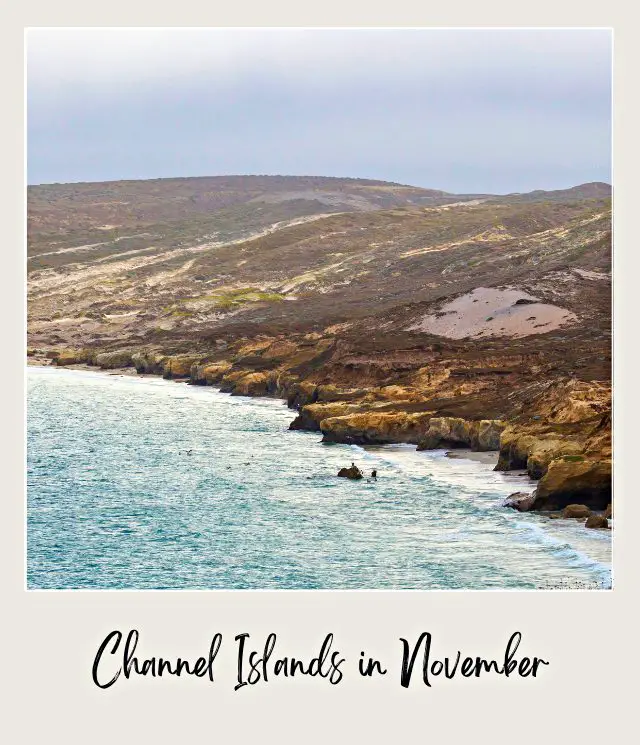
Though you’re approaching the end of the year, you might be surprised to learn how mild the November weather can be at Channel Islands National Park. Daily highs are comparable to those of May, though it can get colder overnight.
Once you’re in November, though, the wet season has begun. This means there’s more chance of stormy weather, which could put a stop to your plans. Earlier in the month this is less likely, though, and ferry services still operate to all five islands for part of November.
The advantage of visiting in the off-season is cheaper prices and fewer crowds. You might also see birds migrating for the winter, so this is a good time of the year for birdwatchers.
Pros
- Birds may be migrating
- Tourist numbers are low
- Some ferries still operate to all five islands
- Diving visibility is good
Cons
- Fewer daylight hours
- Temperatures are dropping
- The wet season has started
Channel Islands National Park – Winter (December – February)
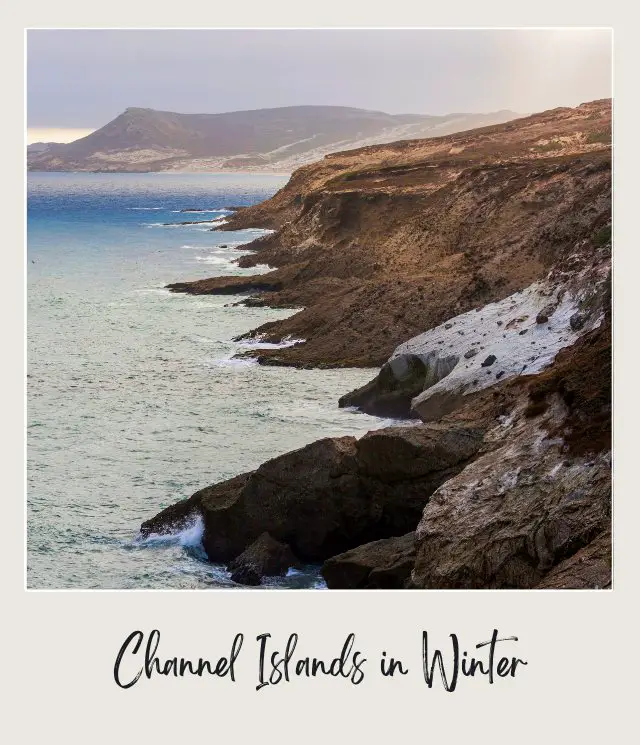
Head to one of the Channel Islands in winter and you might just have the place almost to yourself. The downside is that you’ll only have two islands to choose from at this time of the year – Santa Cruz or Anacapa – unless you have your own boat.
Relative to many other places, though, the weather is fairly mild, so you won’t have to cope with winter extremes here.
Visiting Channel Islands National Park in December
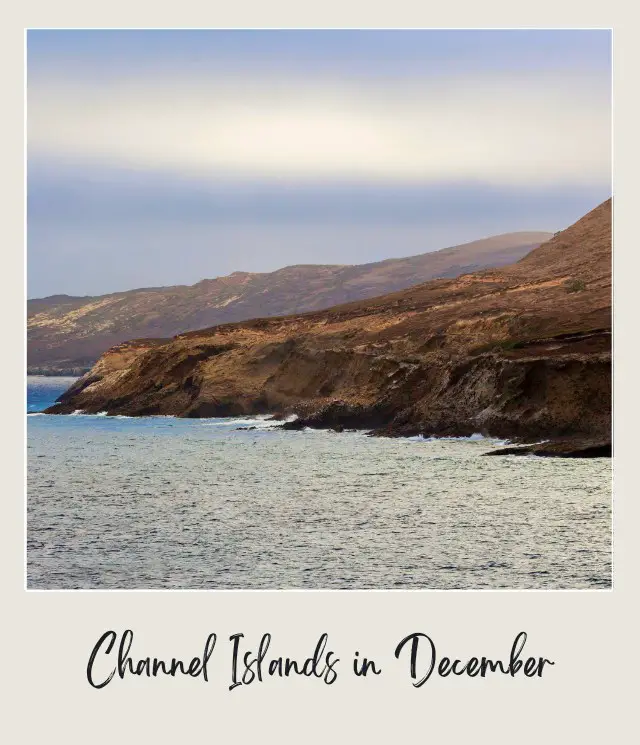
Expect the Channel Islands in California in December to be cold and possibly stormy in comparison to the rest of the year. You can also only reach two of the islands, giving you a choice between Santa Cruz and Anacapa. Or both.
There’s a fairly marked contrast between November and December temperatures at Channel Islands National Park. Daily maximums might be as high as 61°F (16°C), but minimums can dip as low as 37°F (3°C). This is the coldest month of the year, but the mercury still doesn’t tend to go below freezing.
It’s the wet season here in December, so come prepared for stormy weather. You may need to be more flexible when visiting at this time of the year, as cold, wet and windy weather are more likely to affect your plans. On the plus side, the islands have far fewer visitors.
Wildlife to look out for in December includes gray whales toward the end of the month, and northern elephant seal pups being born. The sunsets at this time of year can also be spectacular.
Pros
- Fewer visitors
- No sub-zero temperatures
- Sunsets, gray whales and northern elephant seal pups
Cons
- The coldest month
- Expect wet season storms
- No boats to three of the islands
Visiting Channel Islands National Park in January
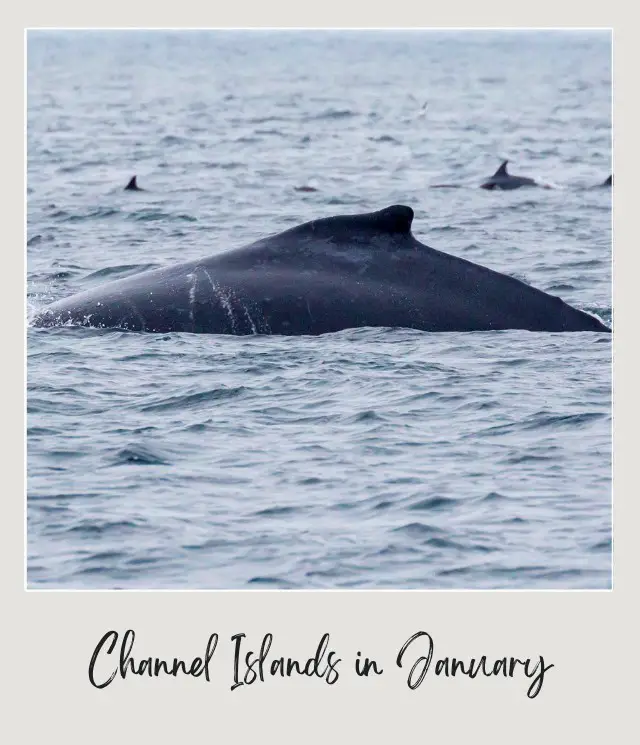
Head to Channel Islands National Park in January and you can expect more of the same. The weather is wet, cold and windy, as in December, and again you can only reach Anacapa or Santa Cruz islands.
January can be less windy than December, though. The Santa Ana winds start to dissipate as the year begins, following their September to December peak period. Average temperatures can be slightly higher than in December, though there’s little difference throughout the winter season.
Average daily temperatures in January range between 39°F (4°C) and 63°F (17°C). This is still the wet season, so come prepared for storms.
In midwinter, expect gray whale watching, stunning sunsets, and nesting Californian brown pelicans.
Pros
- Low visitor numbers
- Less windy than December
- Gray whales, brown pelicans and sunsets
Cons
- Short days
- Stormy weather is likely
- No ferries to Santa Barbara, San Miguel or Santa Rosa and very few to Anacapa
Visiting Channel Islands National Park in February
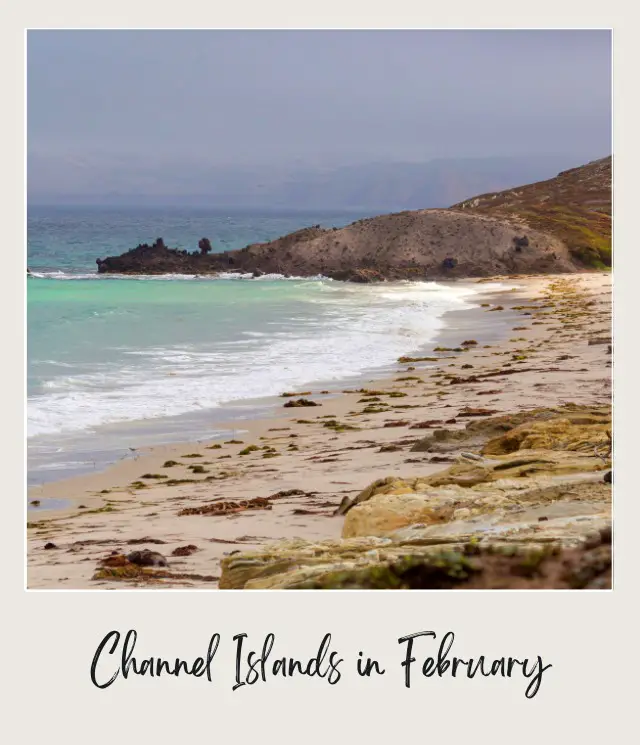
As winter continues in California, the Channel Islands are still cold, wet and stormy in February. Late winter is generally less windy than early winter, however.
February is cold – in relative terms at least. This is California, so it’s mild compared to some parts of the US, but the coastal location does add to the chill factor. Expect temperatures of about 39°F (4°C) overnight, with daytime highs of up to 61°F (16°C).
Again there are no ferries to Santa Barbara, San Miguel or Santa Rosa in February. This means fewer crowds, though.
In late winter, you might see gray whales offshore, plus harbor seal pupping. Pretty sunsets can again be expected, and wildflowers may even begin to bloom by the end of the month.
Pros
- Good sunsets
- Peaceful time to visit
- Gray whales and harbor seal pups
Cons
- More hours of darkness
- A chance of wet season storms
- No ferry services to Santa Barbara, San Miguel, Santa Rosa or Anacapa
Travel Insurance for Channel Islands National Park
No matter when you go to Channel Islands National Park, you should definitely get travel insurance. This can protect you not only against medical and emergency repatriation, but can also cover things like trip cancellation, loss and/ or theft of property, etc.
A great insurance option is Travelex. It has coverage for all you’ll need. You can compare Travel Insurance plans here or get a quote right now:
Enjoy Channel Islands National Park!
Additional Planning Resources for Channel Islands National Park
⭐ Planning A Trip to Channel Islands National Park: 7 Mistakes to Avoid
⭐ Channel Islands SCUBA Diving, California
⭐ How to Get to Channel Islands National Park
⭐ Closest Airport to Channel Islands National Park
⭐ The Airports Near Channel Islands National Park
⭐ Best Time To Visit Channel Islands National Park
⭐ 10 Tips for Visiting Channel Islands National Park
⭐ Fun Facts About Channel Islands National Park
What do you think is the best month to visit Channel Islands National Park? Join my private Facebook group National Parks Collectors and comment and let me know (you can also pick up extra planning tips, share your photos and stories with other national park lovers and more).
Subscribe to daily national parks planning tips, travel inspiration and trip ideas and get instant access to the free PDF of this guide to
“Visiting Channel Islands National Park: What To Expect Throughout the Year”
If you liked this article about Channel Islands National Park, USA, Pin It to your Channel Islands National Park board!


💡 Are you just starting to think about taking a national parks trip? Get Inspiration
‼️ Are you looking for helpful tips for visiting US national parks? Read articles that share useful tips on a range of national-park related issues
💻 Are you starting to plan a trip to Channel Islands National Park? Read my Guide to Channel Islands National Park
💲 Are you ready to book your trip? Use these Planning and Booking Resources
📖 Do you want to read a book about US national parks? Check out my Recommended Reading Lists
About the Author

James Ian is a national park, camping and hiking expert.
He has dedicated his life to travel, visiting more than 80 countries, all 7 continents and most of the national parks in the United States. With over 35 years experience in the travel industry, James has worked on cruise ships, at resorts and hotels, and as a travel planner who’s helped hundreds of people plan successful trips to US national parks.
Based on his experience visiting our national parks multiple times, in-depth research and expertise as a travel planner, James has published detailed itineraries for many of the major national parks in the US. These itineraries, as well as in-depth park guides, and other resources will help you have your own incredible trip to US national parks without stress and hassle.
As a national park expert, James has contributed to many publications, including USA Today, Newsweek, Time Business News, Savoteur, Best Trip, and Wired.
I’m a member of the Amazon Services LLC Associates Program. As an Amazon Associate I earn from qualifying purchases.
